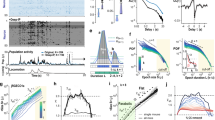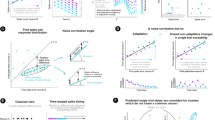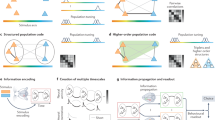Abstract
Cortical neurons show irregular but structured spike trains. This has been interpreted as evidence for 'temporal coding', whereby stimuli are represented by precise spike-timing patterns. Here, we suggest an alternative interpretation based on the older concept of the cell assembly. The dynamic evolution of assembly sequences, which are steered but not deterministically controlled by sensory input, is the proposed substrate of psychological processes beyond simple stimulus–response associations. Accordingly, spike trains show a temporal structure that is stimulus-dependent and more variable than would be predicted by strict sensory control. We propose four signatures of assembly organization that can be experimentally tested. We argue that many observations that have been interpreted as evidence for temporal coding might instead reflect an underlying assembly structure.
This is a preview of subscription content, access via your institution
Access options
Subscribe to this journal
Receive 12 print issues and online access
$189.00 per year
only $15.75 per issue
Buy this article
- Purchase on Springer Link
- Instant access to full article PDF
Prices may be subject to local taxes which are calculated during checkout






Similar content being viewed by others
References
deCharms, R. C. & Zador, A. Neural representation and the cortical code. Annu. Rev. Neurosci. 23, 613–647 (2000).
Theunissen, F. & Miller, J. P. Temporal encoding in nervous systems: a rigorous definition. J. Comput. Neurosci. 2, 149–162 (1995).
Gerstner, W. Pulsed Neural Networks (eds Maas, W. & Bishop, C. M.) 3–49 (MIT Press, Cambridge, Massachusetts, 1999).
Magee, J. C. Dendritic integration of excitatory synaptic input. Nature Rev. Neurosci. 1, 181–190 (2000).
Abeles, M. Role of the cortical neuron: integrator or coincidence detector? Isr. J. Med. Sci. 18, 83–92 (1982).
Konig, P., Engel, A. K. & Singer, W. Integrator or coincidence detector? The role of the cortical neuron revisited. Trends Neurosci. 19, 130–137 (1996).
Spruston, N. & Johnston, D. Perforated patch-clamp analysis of the passive membrane properties of three classes of hippocampal neurons. J. Neurophysiol. 67, 508–529 (1992).
Zhang, Z. W. Maturation of layer V pyramidal neurons in the rat prefrontal cortex: intrinsic properties and synaptic function. J. Neurophysiol. 91, 1171–1182 (2004).
Leger, J. F., Stern, E. A., Aertsen, A. & Heck, D. Synaptic integration in rat frontal cortex shaped by network activity. J. Neurophysiol. 93, 281–293 (2005).
Trevelyan, A. J. & Jack, J. Detailed passive cable models of layer 2/3 pyramidal cells in rat visual cortex at different temperatures. J. Physiol. (Lond.) 539, 623–636 (2002).
Koch, C., Rapp, M. & Segev, I. A brief history of time (constants). Cereb. Cortex 6, 93–101 (1996).
Destexhe, A. & Pare, D. Impact of network activity on the integrative properties of neocortical pyramidal neurons in vivo. J. Neurophysiol. 81, 1531–1547 (1999).
Zhou, Y. D. & Fuster, J. M. Visuo-tactile cross-modal associations in cortical somatosensory cells. Proc. Natl Acad. Sci. USA 97, 9777–9782 (2000).
Kreiman, G., Koch, C. & Fried, I. Imagery neurons in the human brain. Nature 408, 357–361 (2000).
Kosslyn, S. M., Thompson, W. L., Kim, I. J. & Alpert, N. M. Topographical representations of mental images in primary visual cortex. Nature 378, 496–498 (1995).
Sakurai, Y. Involvement of auditory cortical and hippocampal neurons in auditory working memory and reference memory in the rat. J. Neurosci. 14, 2606–2623 (1994).
Tsodyks, M., Kenet, T., Grinvald, A. & Arieli, A. Linking spontaneous activity of single cortical neurons and the underlying functional architecture. Science 286, 1943–1946 (1999).
Kenet, T., Bibitchkov, D., Tsodyks, M., Grinvald, A. & Arieli, A. Spontaneously emerging cortical representations of visual attributes. Nature 425, 954–956 (2003).
Fiser, J., Chiu, C. & Weliky, M. Small modulation of ongoing cortical dynamics by sensory input during natural vision. Nature 431, 573–578 (2004).
Llinas, R. R. & Pare, D. Of dreaming and wakefulness. Neuroscience 44, 521–535 (1991).
Hebb, D. O. The Organization of Behavior (Wiley, New York, 1949).
Tolman, E. C. Purposive Behavior in Animals and Men (Appleton–Century–Crofts, New York, 1932).
Skinner, B. F. The Behavior of Organisms: an Experimental Analysis (Appleton–Century–Crofts, New York, 1938).
Gabbiani, F., Metzner, W., Wessel, R. & Koch, C. From stimulus encoding to feature extraction in weakly electric fish. Nature 384, 564–567 (1996).
Buracas, G. T., Zador, A. M., DeWeese, M. R. & Albright, T. D. Efficient discrimination of temporal patterns by motion-sensitive neurons in primate visual cortex. Neuron 20, 959–969 (1998).
Optican, L. M. & Richmond, B. J. Temporal encoding of two-dimensional patterns by single units in primate inferior temporal cortex. III. Information theoretic analysis. J. Neurophysiol. 57, 162–178 (1987).
Hegde, J. & Van Essen, D. C. Temporal dynamics of shape analysis in macaque visual area V2. J. Neurophysiol. 92, 3030–3042 (2004).
Middlebrooks, J. C., Clock, A. E., Xu, L. & Green, D. M. A panoramic code for sound location by cortical neurons. Science 264, 842–844 (1994).
Panzeri, S., Petersen, R. S., Schultz, S. R., Lebedev, M. & Diamond, M. E. The role of spike timing in the coding of stimulus location in rat somatosensory cortex. Neuron 29, 769–777 (2001).
Katz, D. B., Simon, S. A. & Nicolelis, M. A. Dynamic and multimodal responses of gustatory cortical neurons in awake rats. J. Neurosci. 21, 4478–4489 (2001).
Di Lorenzo, P. M. & Victor, J. D. Taste response variability and temporal coding in the nucleus of the solitary tract of the rat. J. Neurophysiol. 90, 1418–1431 (2003).
Laurent, G. Dynamical representation of odors by oscillating and evolving neural assemblies. Trends Neurosci. 19, 489–496 (1996).
O'Keefe, J. & Recce, M. L. Phase relationship between hippocampal place units and the EEG theta rhythm. Hippocampus 3, 317–330 (1993).
Skaggs, W. E., McNaughton, B. L., Wilson, M. A. & Barnes, C. A. Theta phase precession in hippocampal neuronal populations and the compression of temporal sequences. Hippocampus 6, 149–172 (1996).
Harris, K. D. et al. Spike train dynamics predicts theta-related phase precession in hippocampal pyramidal cells. Nature 417, 738–741 (2002).
Mehta, M. R., Lee, A. K. & Wilson, M. A. Role of experience and oscillations in transforming a rate code into a temporal code. Nature 417, 741–746 (2002).
Huxter, J., Burgess, N. & O'Keefe, J. Independent rate and temporal coding in hippocampal pyramidal cells. Nature 425, 828–832 (2003).
Stopfer, M., Jayaraman, V. & Laurent, G. Intensity versus identity coding in an olfactory system. Neuron 39, 991–1004 (2003).
MacLeod, K., Backer, A. & Laurent, G. Who reads temporal information contained across synchronized and oscillatory spike trains? Nature 395, 693–698 (1998).
Stopfer, M., Bhagavan, S., Smith, B. H. & Laurent, G. Impaired odour discrimination on desynchronization of odour-encoding neural assemblies. Nature 390, 70–74 (1997).
Perez-Orive, J., Bazhenov, M. & Laurent, G. Intrinsic and circuit properties favor coincidence detection for decoding oscillatory input. J. Neurosci. 24, 6037–6047 (2004).
Adrian, E. D. & Zotterman, Y. The impulses produced by sensory nerve endings. Part 2. The response of a single end organ. J. Physiol. (Lond.) 61, 151–171 (1926).
Britten, K. H., Shadlen, M. N., Newsome, W. T. & Movshon, J. A. Responses of neurons in macaque MT to stochastic motion signals. Vis. Neurosci. 10, 1157–1169 (1993).
Softky, W. R. & Koch, C. The highly irregular firing of cortical cells is inconsistent with temporal integration of random EPSPs. J. Neurosci. 13, 334–350 (1993).
Shadlen, M. N. & Newsome, W. T. The variable discharge of cortical neurons: implications for connectivity, computation, and information coding. J. Neurosci. 18, 3870–3896 (1998).
Mazurek, M. E. & Shadlen, M. N. Limits to the temporal fidelity of cortical spike rate signals. Nature Neurosci. 5, 463–471 (2002).
Stevens, C. F. & Zador, A. M. Input synchrony and the irregular firing of cortical neurons. Nature Neurosci. 1, 210–217 (1998).
Bair, W., Zohary, E. & Newsome, W. T. Correlated firing in macaque visual area MT: time scales and relationship to behavior. J. Neurosci. 21, 1676–1697 (2001).
Teich, M. C. Fractal character of the auditory neural spike train. IEEE Trans. Biomed. Eng. 36, 150–160 (1989).
Baddeley, R. et al. Responses of neurons in primary and inferior temporal visual cortices to natural scenes. Proc. R. Soc. Lond. B 264, 1775–1783 (1997).
Kara, P., Reinagel, P. & Reid, R. C. Low response variability in simultaneously recorded retinal, thalamic, and cortical neurons. Neuron 27, 635–646 (2000).
DeWeese, M. R. & Zador, A. M. Shared and private variability in the auditory cortex. J. Neurophysiol. (2004).
Wehr, M. & Zador, A. M. Balanced inhibition underlies tuning and sharpens spike timing in auditory cortex. Nature 426, 442–446 (2003).
DeWeese, M. R., Wehr, M. & Zador, A. M. Binary spiking in auditory cortex. J. Neurosci. 23, 7940–7949 (2003).
Fenton, A. A. & Muller, R. U. Place cell discharge is extremely variable during individual passes of the rat through the firing field. Proc. Natl Acad. Sci. USA 95, 3182–3187 (1998).
Mainen, Z. F. & Sejnowski, T. J. Reliability of spike timing in neocortical neurons. Science 268, 1503–1506 (1995).
Fellous, J. M., Tiesinga, P. H., Thomas, P. J. & Sejnowski, T. J. Discovering spike patterns in neuronal responses. J. Neurosci. 24, 2989–3001 (2004).
Gerstein, G. L. & Mandelbrot, B. Random walk models for the spike activity of a single neuron. Biophys. J. 71, 41–68 (1964).
Chance, F. S., Abbott, L. F. & Reyes, A. D. Gain modulation from background synaptic input. Neuron 35, 773–782 (2002).
Berry, M. J., Warland, D. K. & Meister, M. The structure and precision of retinal spike trains. Proc. Natl Acad. Sci. USA 94, 5411–5416 (1997).
Bair, W. & Koch, C. Temporal precision of spike trains in extrastriate cortex of the behaving macaque monkey. Neural Comput. 8, 1185–1202 (1996).
Harris, K. D., Csicsvari, J., Hirase, H., Dragoi, G. & Buzsaki, G. Organization of cell assemblies in the hippocampus. Nature 424, 552–556 (2003).
Wood, E. R., Dudchenko, P. A., Robitsek, R. J. & Eichenbaum, H. Hippocampal neurons encode information about different types of memory episodes occurring in the same location. Neuron 27, 623–633 (2000).
Oram, M. W., Foldiak, P., Perrett, D. I. & Sengpiel, F. The 'ideal homunculus': decoding neural population signals. Trends Neurosci. 21, 259–265 (1998).
Ghazanfar, A. A., Stambaugh, C. R. & Nicolelis, M. A. Encoding of tactile stimulus location by somatosensory thalamocortical ensembles. J. Neurosci. 20, 3761–3775 (2000).
Furukawa, S., Xu, L. & Middlebrooks, J. C. Coding of sound-source location by ensembles of cortical neurons. J. Neurosci. 20, 1216–1228 (2000).
Oram, M. W., Hatsopoulos, N. G., Richmond, B. J. & Donoghue, J. P. Excess synchrony in motor cortical neurons provides redundant direction information with that from coarse temporal measures. J. Neurophysiol. 86, 1700–1716 (2001).
Engel, A. K., Fries, P. & Singer, W. Dynamic predictions: oscillations and synchrony in top-down processing. Nature Rev. Neurosci. 2, 704–716 (2001).
Riehle, A., Grun, S., Diesmann, M. & Aertsen, A. Spike synchronization and rate modulation differentially involved in motor cortical function. Science 278, 1950–1953 (1997).
Fries, P., Reynolds, J. H., Rorie, A. E. & Desimone, R. Modulation of oscillatory neuronal synchronization by selective visual attention. Science 291, 1560–1563 (2001).
von Stein, A., Chiang, C. & Konig, P. Top–down processing mediated by interareal synchronization. Proc. Natl Acad. Sci. USA 97, 14748–14753 (2000).
Gray, C. M., Konig, P., Engel, A. K. & Singer, W. Oscillatory responses in cat visual cortex exhibit inter-columnar synchronization which reflects global stimulus properties. Nature 338, 334–337 (1989).
Wilson, M. A. & McNaughton, B. L. Reactivation of hippocampal ensemble memories during sleep. Science 265, 676–679 (1994).
Louie, K. & Wilson, M. A. Temporally structured replay of awake hippocampal ensemble activity during rapid eye movement sleep. Neuron 29, 145–156 (2001).
Skaggs, W. E. & McNaughton, B. L. Replay of neuronal firing sequences in rat hippocampus during sleep following spatial experience. Science 271, 1870–1873 (1996).
Lee, A. K. & Wilson, M. A. Memory of sequential experience in the hippocampus during slow wave sleep. Neuron 36, 1183–1194 (2002).
Nadasdy, Z., Hirase, H., Czurko, A., Csicsvari, J. & Buzsaki, G. Replay and time compression of recurring spike sequences in the hippocampus. J. Neurosci. 19, 9497–9507 (1999).
Kudrimoti, H. S., Barnes, C. A. & McNaughton, B. L. Reactivation of hippocampal cell assemblies: effects of behavioral state, experience, and EEG dynamics. J. Neurosci. 19, 4090–4101 (1999).
Hoffman, K. L. & McNaughton, B. L. Coordinated reactivation of distributed memory traces in primate neocortex. Science 297, 2070–2073 (2002).
Hirase, H., Leinekugel, X., Czurko, A., Csicsvari, J. & Buzsaki, G. Firing rates of hippocampal neurons are preserved during subsequent sleep episodes and modified by novel awake experience. Proc. Natl Acad. Sci. USA 98, 9386–9390 (2001).
Usrey, W. M. & Reid, R. C. Synchronous activity in the visual system. Annu. Rev. Physiol. 61, 435–456 (1999).
Constantinidis, C., Franowicz, M. N. & Goldman-Rakic, P. S. Coding specificity in cortical microcircuits: a multiple-electrode analysis of primate prefrontal cortex. J. Neurosci. 21, 3646–3655 (2001).
Csicsvari, J., Hirase, H., Czurko, A. & Buzsaki, G. Reliability and state dependence of pyramidal cell-interneuron synapses in the hippocampus: an ensemble approach in the behaving rat. Neuron 21, 179–189 (1998).
deCharms, R. C. & Merzenich, M. M. Primary cortical representation of sounds by the coordination of action-potential timing. Nature 381, 610–613 (1996).
Vaadia, E. et al. Dynamics of neuronal interactions in monkey cortex in relation to behavioural events. Nature 373, 515–518 (1995).
Bartho, P. et al. Characterization of neocortical principal cells and interneurons by network interactions and extracellular features. J. Neurophysiol. 92, 600–608 (2004).
Marshall, L. et al. Hippocampal pyramidal cell-interneuron spike transmission is frequency dependent and responsible for place modulation of interneuron discharge. J. Neurosci. 22, RC197 (2002).
Csicsvari, J., Jamieson, B., Wise, K. D. & Buzsaki, G. Mechanisms of gamma oscillations in the hippocampus of the behaving rat. Neuron 37, 311–322 (2003).
Bi, G. Q. & Poo, M. -M. Synaptic modifications in cultured hippocampal neurons: dependence on spike timing, synaptic strength, and postsynaptic cell type. J. Neurosci. 18, 10464–10472 (1998).
Magee, J. C. & Johnston, D. A synaptically controlled, associative signal for Hebbian plasticity in hippocampal neurons. Science 275, 209–213 (1997).
Singer, W. Synchronization of cortical activity and its putative role in information processing and learning. Annu. Rev. Physiol. 55, 349–374 (1993).
Marr, D. Simple memory: a theory for archicortex. Philos. Trans. R. Soc. Lond. B 262, 23–81 (1971).
Gardner-Medwin, A. R. The recall of events through the learning of associations between their parts. Proc. R. Soc. Lond. B 194, 375–402 (1976).
Hopfield, J. J. Neural networks and physical systems with emergent collective computational abilities. Proc. Natl Acad. Sci. USA 79, 2554–2558 (1982).
Amit, D. The Hebbian paradigm reintegrated: local reverberations as internal representations. Behav. Brain Sci. 18, 617–626 (1994).
Wallenstein, G. V. & Hasselmo, M. E. GABAergic modulation of hippocampal population activity: sequence learning, place field development, and the phase precession effect. J. Neurophysiol. 78, 393–408 (1997).
Izhikevich, E. M., Gally, J. A. & Edelman, G. M. Spike-timing dynamics of neuronal groups. Cereb. Cortex 14, 933–944 (2004).
Barlow, H. B. Single units and sensation: a neuron doctrine for perceptual psychology? Perception 1, 371–394 (1972).
Acknowledgements
I thank G. Buzsaki, S. Montgomery and E. Ludvig for comments on the manuscript. K.D.H. is supported by NIH and an Alfred P. Sloan research fellowship.
Author information
Authors and Affiliations
Ethics declarations
Competing interests
The author declares no competing financial interests.
Related links
Rights and permissions
About this article
Cite this article
Harris, K. Neural signatures of cell assembly organization. Nat Rev Neurosci 6, 399–407 (2005). https://doi.org/10.1038/nrn1669
Issue Date:
DOI: https://doi.org/10.1038/nrn1669
This article is cited by
-
Aversive stimulus-tuned responses in the CA1 of the dorsal hippocampus
Nature Communications (2023)
-
Controlling neuronal assemblies: a fundamental function of respiration-related brain oscillations in neuronal networks
Pflügers Archiv - European Journal of Physiology (2023)
-
Inhibition allocates spikes during hippocampal ripples
Nature Communications (2022)
-
Neuromodulator-dependent synaptic tagging and capture retroactively controls neural coding in spiking neural networks
Scientific Reports (2022)
-
Learning orientations: a discrete geometry model
Journal of Applied and Computational Topology (2022)



